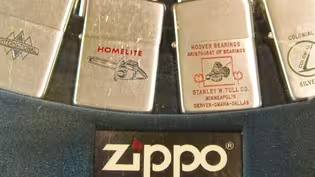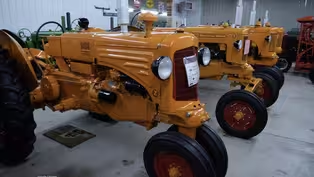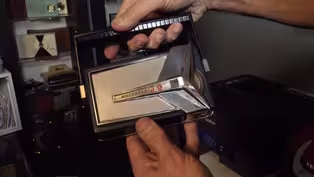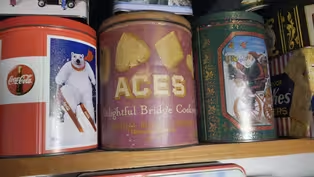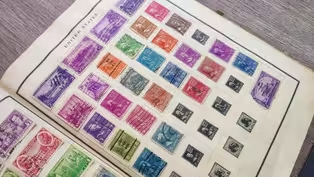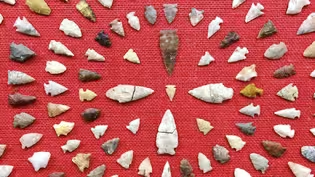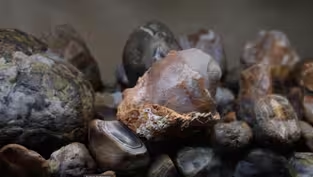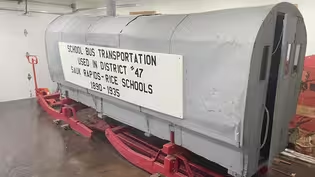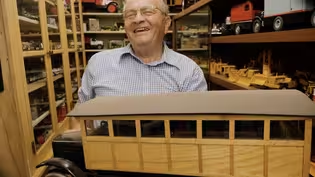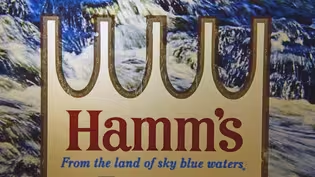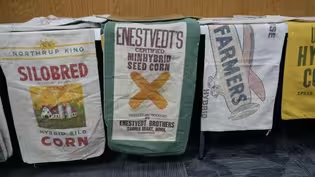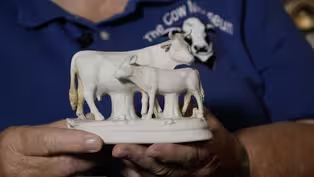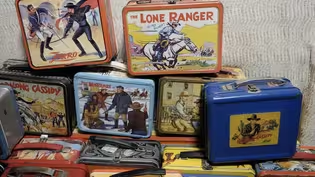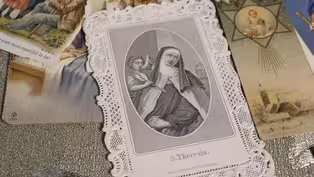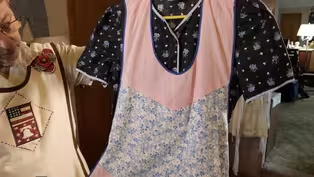LANDMARKS
LANDMARKS: Minnesota Collections
2/24/2024 | 1h 26m 42sVideo has Closed Captions
Host Doug Ohman meets people in Minnesota that have a passion for collecting.
Travel along with Minnesota storyteller Doug Ohman as he meets people in Minnesota that have a passion for collecting. Along with sharing their treasured collections with him, they will tell their stories on how they started collecting and why they collect. See everything from vintage tractors and the world's largest collection of cow knickknacks to old toys and movie posters.
Problems playing video? | Closed Captioning Feedback
Problems playing video? | Closed Captioning Feedback
LANDMARKS is a local public television program presented by Pioneer PBS
This program is made possible by contributions from the voters of Minnesota through a legislative appropriation from the Arts and Cultural Heritage Fund and viewers like you.
LANDMARKS
LANDMARKS: Minnesota Collections
2/24/2024 | 1h 26m 42sVideo has Closed Captions
Travel along with Minnesota storyteller Doug Ohman as he meets people in Minnesota that have a passion for collecting. Along with sharing their treasured collections with him, they will tell their stories on how they started collecting and why they collect. See everything from vintage tractors and the world's largest collection of cow knickknacks to old toys and movie posters.
Problems playing video? | Closed Captioning Feedback
How to Watch LANDMARKS
LANDMARKS is available to stream on pbs.org and the free PBS App, available on iPhone, Apple TV, Android TV, Android smartphones, Amazon Fire TV, Amazon Fire Tablet, Roku, Samsung Smart TV, and Vizio.

Providing Support for PBS.org
Learn Moreabout PBS online sponsorship(gentle bright music) - Hello and welcome to another Landmarks program.
My name is Doug Ohman and I can't wait to take you on another Minnesota adventure.
We are going to explore the fun, creative, and interesting world of collecting.
Most of us, if we think about it, know someone who has a passion for collecting.
It might be knickknacks, toys, fishing lures, or old vintage cars.
Whatever the collection is, let's go together and find the story.
The items people collect are fun to see, but the story on how and why people collect can be the most interesting part.
We will travel together, make some new friends, but be assured, we will see some really cool collections.
(gentle music) (pensive music) You can find collections in towns, neighborhoods, and in cities, but it's always fun to travel to rural Minnesota on a discovery mission.
South of Fairmont, almost on the Iowa border.
I find a guy that has a passion for toys.
He not only collects them, but he also restores them.
Norm Langford and his wife live the country life.
- [Norm] How you doing?
- [Doug] In what some would call God's country.
- Good to see you again.
- [Doug] Norm takes me on a short walk to see his collection in a converted corn crib.
- Well, Doug, this is my shop.
- This is cool.
So where's the collection that you're so proud of?
- It's behind this door here.
(curious music) - Wow.
Norm, this is amazing.
- What do you think, Doug?
- Where do you even start?
- [Norm] Well, I've been at it for 40 years and it's been my passion for 40 years and no end to the fun.
- So you not only collect toys, but you actually restore some of these 'cause some of these didn't come in this condition when you received them.
- [Norm] Right, I restored many of them.
- [Doug] Well, show me some of your favorites.
- One of my favorites is this MIC Smith Miller Truck.
They've all got this fancy chrome grill and I repainted 'em all.
They're real easy to restore because they come apart.
They're put together with screws, so they come apart real easy.
- Wow, they're made solid, too.
- Yeah, they're made solid.
- Wow.
They're heavy.
- Aluminum, cast aluminum.
- I bet that's 10 pounds.
- Yeah, it's close to that.
- So do you prefer to find an old, rusty old used toy and bring it back to life?
- Yeah, that's the cheapest ones when you take an old one that nobody else wants.
(laughs) - Yeah, absolutely.
But look what you've done with some of 'em.
It's just amazing.
And not only trucks, you have tractors.
(reflective music) So what was your first project?
Do you still have it today?
- Yeah, I still have it.
It was one of these John Deere tractors here.
Yeah, this looks like it, the first one I did, this is one I found out in a junk pile.
- [Doug] That looks like it was bought yesterday.
- Yep.
- You have some cars too?
- [Norm] Yeah, I've got a few cars over in this other cabinet.
- [Doug] But I can't help but notice the train set you have running on the floor here.
- [Norm] Yeah, that's also Buddy.
These were made in the 1920s.
They quit making 'em in about 1932.
- [Doug] Are they desirable?
The trains?
- Yeah.
- Collector wise.
- [Norm] Yeah, they are.
The trains are quite collectible, especially the engine and these three cars and the caboose in the back.
- Yeah.
So Norm, what is the future of your collection?
- [Norm] Well, I don't think I'm going to add very much to it anymore.
Once in a while I pick up a small piece, you know, here and there and- - Is it going to kids, family?
As collectors age, the question of what the future is of the collection is often asked.
If family is not interested, maybe a local museum will be an option.
Most collectors I met are not interested in selling, but they all hope that years from now someone will appreciate the passion they had.
(upbeat music) (playful music) After visiting with Norm, I'm now back in the town of Fairmont and I can't help wondering why this charming Minnesota town has so many hogs on the loose.
Okay, they're not real hogs, but statues of hogs.
People may not believe me, so I need to get some up close pictures.
(playful music) (camera clicks) (playful music) - So you like my pig, my hog?
- I do!
- I'm Jeff.
- Jeff, I'm Doug.
Nice to meet you.
- Glad to meet you, Doug.
- Tell me the story of these.
As I drove into town, I saw three or four of these out in front of other businesses.
And what's the deal?
- Well, there are a lot of 'em throughout the county.
There's in fact 88 in the county right now, and 15 more scheduled to go in front of different businesses throughout the county.
We're a small group of volunteers that started this with the goal of spotlighting our businesses to feature our local artists and our pork industry 'cause I don't know if you know this, but we're the pork capital of the state of Minnesota.
- So your hog, as I can see here, represents movies, theater.
- I'm a film and and movie buff.
And it seemed appropriate to do something that honored that type of thing.
And so I made it according to that.
- So this is your business here?
- Yes, it's called Our Story Studios.
We're a local television program that spotlights local businesses.
- Well, Jeff, I'm doing a program on collections, unique collections.
- Oh really?
- And what I love about the hog story, it's a community collection.
- Absolutely.
And so many people are involved with a hundred businesses involved and 24 local artists.
It is definitely a community project.
But you're doing what?
A story on what?
- On interesting collections, people that collect things and the stories about their collection.
- Oh, oh.
Why don't you come in and take a look?
I think you might be surprised.
(magical music) - [Doug] Jeff, what is this?
- Well, this is where I shoot a lot of our TV show, but this is mostly part of my collection.
We've incorporated a collection of different things throughout the whole building that are pretty much my interests.
- But Jeff, when I look around here, I see old TVs, radios, film.
That is your interest.
- Entertainment, old entertainment is my interest.
- Old entertainment.
- Hmm hmm.
Doug, you might like this room, but now I'm gonna show you my mancave.
I think you'll like that.
Well, I've been collecting for probably 35 years.
I used to own a poster and art print company that specializes in original movie poster.
That was my bread and butter for many years.
And then after that, this evolved into a personal collection.
Basically anything that reminds me of my youth or the history of film and television, because that's my hobby.
- [Doug] So this is more than a collection really?
This is really personal to you, I can tell.
- Yeah.
It's pretty much everything that reminds me of my youth.
You know, whether it be the telephones, the TVs, the television show memorabilia, film memorabilia, it's just all things that I like.
Some of them are very valuable, some have no value at all, and it makes no difference.
I treasure some of the ones that have no value more than some of the ones that have some value.
- That's a true collector.
(Jeff laughs) It really is.
Well, I love it.
- [Jeff] Thank you so much for stopping!
(light happy music) - [Doug] Today, I'm in the beautiful river town of Mankato to see a most unique collection.
Yvonne Cariveau is a collector of holy cards.
My question, and maybe yours as well, what is a holy card?
Well, I think I'm about to find out.
- You're probably wondering what a holy card is.
I've been collecting them for a long time, so I can tell you a little bit about what they are and what they aren't.
- Awesome.
I wanna learn.
- Okay.
So I have some laying out here.
Holy cards, typically in the Catholic holy cards, typically have a saint, or they'll have the Virgin Mary or Jesus on them.
So they'll have some kind of a artwork.
And then they may have a prayer, or they may have information about somebody in the back.
They're typically about this size.
They were put into Bibles.
They were given out as prizes for Sunday school students.
They were used at funerals to memorialize someone who had passed away.
They're a real important part of the Roman Catholic tradition and culture because they were used to help explain the stories and the Catholic religion.
- [Doug] So how did you get started collecting holy cards?
I mean, it's a unique collection idea.
I love it.
- Yeah.
- [Doug] But how did you do it?
- Actually, my mother and father gave me my first holy cards, and I think it was my mom that put it in a present.
And she said, "This is something you might like."
- With all your cards.
- Hmm hmm.
- [Doug] How many do you have?
I mean, is your collection large?
Is it small?
Where are you at?
- I think it's a pretty big collection.
There isn't a, you know, definitive guide to how many cards everybody has out there.
But I estimate I have about 1500.
- [Doug] How do you find them?
- (chuckles) They actually like fall out of Bibles and fall out of people's books an awful lot.
Occasionally you'll find them in antique shops in the postcard section.
- [Doug] Are you still looking for cards?
- Oh, yeah, yeah, I still...
Occasionally, I'll go rummaging around in an antique shop and look for them, and once in a while I'll look online.
If I know that I'm missing a particular one, I'll go online and see if maybe somebody has it for sale.
- [Doug] Yvonne, when I look at your cards.
- Hmm hmm.
- I see a lot of history.
- The earliest card that I know about was made in 1432, and it's a woodcut of St. Christopher.
- Do you have it?
- No.
(laughing) That one's in Germany, in a museum someplace.
- [Doug] Can you follow the historical timeline when you see a card that you know kind of, "Yeah, that's from the 1840s and that's from the 1940s."
- I'm getting better at it.
I'm not, it's not perfect.
It's not an exact thing.
These are for events and the card, like here's one for John F. Kennedy.
- Oh, sure.
- And that was a holy card that was printed after his assassination.
- Yes.
- [Yvonne] And so that would be 1963.
- [Doug] And this isn't a reproduction, this is the real deal.
- Yeah, that was one of the cards that was distributed.
I'm sure they printed millions of them, but you know, how many of them have survived for exactly 50, 60 years now?
- [Doug] It's immaculate.
No, it's so great that you've saved them.
- You know, if they have the dates on them, that's great.
The rest of them, it's a bit of detective work.
- [Doug] It's a treasure hunt for you, isn't it?
- [Yvonne] It is a treasure hunt.
(laughs) - [Doug] And I noticed you have one, a military one there.
- Yeah, I actually have two of them here that are from World War II.
One company, something like 500 million holy cards.
And they were given out through the American Red Cross and through the folks that went out and entertained the troops.
- Yeah.
Right.
- And they would hand those out to any of the troops that wanted them.
And it was a little something that a soldier could keep close to him that might remind him of his religion, his home.
- [Doug] And we will never know the impact on one of these little cards.
- Right.
- [Doug] And the artwork is just, just beautiful.
- [Yvonne] Yeah, yeah, I mean, there's some amazing artists.
If you get a magnifying glass and really look in there, there'll be little things like rings and buttons and little stars and things like that that are just lovely.
As you know, like with photographs and stuff, colors will fade if they're exposed to the sun, if they get too much light.
And this is just paper, right?
So real easy for it to get crumpled or ripped.
So I love taking good care of 'em.
- [Doug] It's kind of like a baseball card collection, right?
- It is.
Yeah.
Like trading cards for God.
(laughing) - Trading cards for God.
- Yeah, exactly.
(gentle music) - [Doug] Now, most of the cards that I've seen here look like, to be Catholic.
- Yes.
- Are there Protestant cards?
- In the Protestant church, especially Baptists, they do lesson cards.
So they are holy cards, but they're not used in the same way.
They're not depictions, for example, of saints and Mary and Jesus.
They are lessons.
So they're to be used, for example, for Sunday school.
- [Doug] Sure.
- [Yvonne] Or to teach someone the stories of the Bible.
- [Dough] Yvonne, if I find a holy card.
- [Yvonne] Ah huh.
- [Doug] What should I do with it?
- [Yvonne] Well, you could start collecting (laughing), but if you don't wanna do that, or if you have, you know, a bunch of them and you just wanna clear out your house or whatever, the church actually recommends that you give them away, burn them or bury them, that you don't recycle them or throw them in the trash.
And the reason for that is that they potentially could have been blessed.
So they potentially could be religious objects in that sense.
Of course, you can give 'em to me.
I would love it.
(laughing) - [Doug] After leaving Yvonne's, I can't wait to get home to check my grandmother's Bible.
Will there be a rare holy card placed between the old brittle pages?
(gentle music) (light bright music) An hour south of Mankato, I meet up with an old friend.
Yvonne Cory lives near the small farming community of Easton.
Seeing Yvonne at her farm feels like a reunion.
Yvonne has a passion for aprons and is more than willing to share her story with me.
- Yeah, and it's made out of a feed sack.
- [Doug] Yvonne, thank you for having me in your home to see your collection of aprons.
Of course, I wanna know how you ever got started in this amazing collection.
- It's gotta go back to my childhood.
It was an important little gift that I received.
And it was this little sewing machine, little hand crank sewing machine.
- That's a toy?
- It's a real sewing machine.
It sews a chain stitch.
And that's how I learned to sew and learning to sew, and my mother always sewed our aprons, and lots of other things for our home, but I'd watch her for hours and then I'd go to my little sewing machine and I'd start cutting, and then I'd start cranking and I'd put stitches in the cloth.
And that's how I learned to sow.
And so throughout the years, this passion has started to like, you plant a seed and then it grows and it grows.
And that's exactly what's going on here today.
- [Doug] How many years have you been collecting?
- Well, the actual collecting started in 2010.
However, there were a few aprons that I received as a result of the death of my grandmother and my mother.
- [Doug] So it started very personal for you, didn't it?
- [Yvonne Cory] Yes, Grandma Mary always wore one.
I can still see Grandma Mary when she would come to our house wearing her apron, whether it was the pink one, the blue one, or the red one, or whatever.
- [Doug] Did you ever think your collection would grow to the amount that it is today?
- [Yvonne Cory] No.
Never, never.
It's an amazing journey.
- [Doug] So of course, I wanna know, how many do you have?
- [Yvonne Cory] Well, today, right now, I have 1,563 aprons.
- [Doug] Not even a round number.
You know specifically what you have.
- I do!
- Which is really cool.
Yvonne, are aprons a historic story?
- Definitely, a historic story.
It follows all of the timelines of history.
And I have an apron from the Civil War with a southern bell on it.
This is my oldest apron that I claim to have in my collection.
- [Doug] Wow, where in the world did you get that?
- Would you believe, down in Texas, in a bin of aprons, for $1.
(gentle music) And then this is another one of my very prized, and this is coming into the beginning of the 1900s.
It's a very short little apron.
It's got insets in it, and they pinned it on.
It does not have a neck strap to hold it.
So much history.
And as you come down through the decades from the Civil War to those Victorian era, Edwardian era, and then you come into the roaring twenties, that's a whole 'nother area.
(roaring 20's music) You talk about roaring twenties.
- [Doug] Yes.
Here's the long waistline.
- Yes.
- [Yvonne Cory] But what's interesting about it is this, the skirt is probably the original.
The thirties, a time of depression, 1930s depression era where they used the string that they closed the bag with for the embroidery thread.
And then of course, the forties, and the wars were definitely a part of the apron.
The 1950s, when the apron became the icon for the American homemaker.
The advertising and all of the different things that was going on during the fifties after the war, kind of made her the queen of the kitchen.
- [Doug] How did the sixties change?
- In the sixties, the sixties of course, was that bold color.
We got into a lot of boldness, bright colors.
And the seventies, oh my gosh, we got the wild seventies.
But what's interesting about the seventies, the apron followed the style of dress.
In the seventies, remember we had the long dresses come back for just a short period of time.
The apron also is long, as well.
- [Doug] Where do you see aprons going into the future?
- I see aprons coming back.
Oh, here's one.
Just for you, Doug.
We've gotta see all sides of it.
- Oh, yeah, this is good.
- Yes.
- This is good.
- Boys could wear aprons, right?
- Oh, definitely.
Oh, yes, yes!
- Now it wasn't only for the kitchen.
Could an apron be used in the shop or the garage?
- Definitely.
Definitely.
Remember those nail aprons?
- Yes.
- Yes.
Let me show you an an important nail apron of my life.
- I wanna see it.
- I bet you do.
How about this one?
- Lamperts Lumber, - Lamperts Lumberyard of Huntley, Minnesota.
And this is father- - How do I know it says Huntley?
It doesn't say Huntley on it.
- Because Father Albert lived in Huntley.
- And he's not gonna lie.
- No.
(both laughing) And he never did lie.
(laughing) - But Lamberts is a big name in Minnesota.
- Yes, yes.
- But this is my dad's.
- Oh.
- Nail apron.
- And I can see my uncles.
I can see my dad and my grandfather.
They wore these as a accessory to their clothing every day because they were carpenters.
- Carpenters, yes.
And look at how frugal Father... Doug, I want you to understand that every apron has a story.
Every apron has a past.
And every apron has history.
And that's why I have such a deep passion for all these aprons.
(gentle music) - I hope you found our first few collectible stories interesting and fun.
Did Jeff's old film and TV memorabilia bring you back to your own childhood?
I never thought an old paper card from my grandmother's Bible could be such a collectible relic.
I guess, you just never know.
I hope you've enjoyed watching this first segment of Landmarks Minnesota Collections, which has been made possible by the contributions of viewers of Pioneer PBS and other funding.
If you are wondering how you can support programs like Landmarks and what it takes to become a member of Pioneer PBS, watch this.
- [Narrator] The Landmarks Minnesota Collections DVD can be yours with a contribution of $5 on an ongoing monthly basis, or with a single contribution of $60.
With an ongoing contribution of $15 monthly or a one-time gift of $180, we'll send you the Landmarks with Doug Ohman Minnesota Collections DVD plus the How Expert Guide to Collectibles, 101 Plus Tips to Find, Buy, Sell, and Collect Collectibles hardcover book.
With a $25 monthly sustaining contribution, or a one-time gift of $300, we will send you the Landmarks Minnesota Collections DVD plus the How Expert Guide to Collectibles hardcover book, and Kovels Antiques and Collectibles Price Guide 2023 paperback book.
Please make the decision to give right now.
And thank you.
(pensive music) - [Narrator] Sustaining membership is an easy, convenient, and affordable way to support the programs you love.
Sustaining members make an ongoing monthly contribution from either their credit card or checking account.
Just choose the monthly amount you'd like to give, then go online or call and we'll get it set up for you.
Your donation will happen automatically each month, so your support will always be current.
If you wanna change your sustaining membership, just contact us.
Monthly contributions begin as low as $5 per month.
Go online or call to start your sustaining membership right now.
- Here's another short clip of another fun collectible story I found in Benson, Minnesota.
(upbeat music) Greg, I see you collect something very unique, food tins.
How did you ever get started collecting tins?
- I got started collecting tins just kind of by accident.
Over the years, I've gone to several garage sales.
And I would pick them up here and there.
And they're always plentiful and they're always inexpensive and I usually would pick 'em up because I had just a practical use for them to store things.
Or maybe I liked the design.
Maybe I would use it to decorate just a little bit.
But that isn't really how I got into it, was to decorate with them.
But I just picked them up here and there.
And then I came across, one of my favorite ones was this one with the train on it here.
Then I started realizing that they were little works of art.
They were little pieces of art, either photographs or paintings that somebody had painstakingly put time into.
And then one thing led to another and I started to just collect 'em and display 'em.
(upbeat music) - The colors have changed a little bit over the years.
- [Greg] Right.
Yeah.
- [Doug] I wonder which one's older.
This has the recipe book offer.
- That one has the product in grams and this one doesn't.
So I'm going to guess this one's older.
- Yeah.
Yeah.
(upbeat music) (Greg faintly speaking) - [Doug] See first gotta say first and last name.
- Greg Burnham.
- Spelling?
- Greg, G-R-E-G. Burnham, B-U-R-N-H-A-M. - Campbell Soup Yeah, that's pretty cool.
(gentle reflective music) When I see your collection, I go back in time.
I see products that I haven't seen since I was a kid.
That's what's really cool about your collection.
- Well, you know, and I think that, you know, when you look at the like the saltine cracker tin.
- Yeah.
- That brings everybody back to their grandma's house, I think.
- Yes.
(gentle reflective music) You know, the Old Dutch potato chip tin, a very, like, we were talking, a very Minnesota product and again, just hearkens back to a simpler time.
(gentle reflective music) That is something that I like about the tins, too, is I think they say something.
A lot of the tins have illustrations on 'em that say something about our culture, about the holidays, about family time, about just enjoying a simple life.
- Yes, the goodness of life.
- Yeah.
- [Doug] Is shown through the tins.
The other thing I like about 'em, Greg, they're very colorful.
And I'm almost feeling like I'm looking at a Norman Rockwell painting.
- They do serve the practical purpose of being a great decoration.
This is a downstairs extra bedroom that we have.
Behind my tins is a boring, drab cinder block wall that I have hidden with this explosion of color and with the color kind of a commentary.
And that's kind of what I like about it.
I am hoping that someday one of my kids will want my collection and they'll be able to hang onto it and pass it down because I have put some time into assembling all these.
And so I'm hoping somebody can enjoy 'em 50, a hundred years down the road.
(gentle reflective music) - We wanna remind all our viewers that we appreciate your generosity in supporting programs like this on Pioneer PBS.
Our volunteers will be here standing by for your call of support.
Please call now with your contribution to Pioneer PBS at 1-800-726-3178.
Or you can go online to pioneer.org.
- [Narrator] The Landmarks Minnesota Collections DVD can be yours with a contribution of $5 on an ongoing monthly basis, or with a single contribution of $60.
With an ongoing contribution of $15 monthly or a one-time gift of $180, we'll send you the Landmarks with Doug Ohman Minnesota Collections DVD plus the How Expert Guide to Collectibles, 101 Plus Tips to Find, Buy, Sell, and Collect Collectibles hardcover book.
With a $25 monthly sustaining contribution or a one-time gift of $300, we will send you the Landmarks Minnesota Collections DVD plus the How Expert guide to collectibles hardcover book and Kovels Antiques and Collectibles Price Guide 2023 paperback book.
Please make the decision to give right now.
And thank you.
(reflective music) - [Narrator] Sustaining membership is an easy, convenient, and affordable way to support the programs you love.
Sustaining members make an ongoing monthly contribution from either their credit card or checking account.
Just choose the monthly amount you'd like to give, then go online or call and we'll get it set up for you.
Your donation will happen automatically each month, so your support will always be current.
If you wanna change your sustaining membership, just contact us.
Monthly contributions begin as low as $5 per month.
Go online or call to start your sustaining membership right now.
(upbeat music) - Stay tuned for this next segment of Minnesota Collections.
We will continue to travel together throughout Minnesota, exploring both large and small items that people have a serious passion for collecting.
My next collection stop takes me into central Minnesota.
Outside the town of Sauk Rapids lives Ernie Wallach with what might be one of the largest tractor collections in the state.
He not only has a lot of them, but he has some incredibly rare ones, as well.
To start with, Ernie wants to show me his assorted collection in what he calls his man cave.
I notice there isn't one particular theme, it's just vintage anything.
- It's kind of anything.
- Yeah, I like that.
- [Ernie] It catches my eye and I kind of, you know, go after it.
- [Doug] I notice all the trophies, too.
- [Ernie] Well, it goes back to, we raced a lot of dirt track races.
My twin daughters raced.
- [Doug] By the looks of it, you not only raced, you won!
- Over 700 races.
- [Doug] I love the gas pumps, too.
- Yeah, this here gas pump is a pretty rare wanes.
It's a showcase.
You don't find them.
So that's a pretty neat piece.
Sometimes you just find it and you buy it.
- [Doug] Ernie, when I think of collections, I think of things like stamps, knickknacks, baseball cards, small stuff.
But when I look at your collection, this isn't small at all.
- No, you've seen my small stuff in the man cave here.
This is big stuff.
This is big iron.
We have every model, every color tractors.
This is a lot of iron here.
- [Doug] Why tractors?
- [Ernie] Well, I grew up on a farm and I kind of had a passion for tractors.
- [Doug] So how many tractors do you currently have?
- 136, 137.
I didn't really sit down and count exactly, but I know it's over 136.
- [Doug] And I'll bet each one of those tractors, there's a story.
- Yes.
And it is, it's when we'd go hunting, each tractor had where it came from, why I bought it, you know, did a friend have it?
Did a old farmer have it?
You know, we went all over the country to get some of these.
- [Doug] No, I look around.
I don't even know where to start to look.
I want to ask you about each one of these.
- [Ernie] Well, there's a story behind each one.
- I'll bet there is.
- Yeah.
So Doug, this is a model scale of the big, big boys, the oil Twin City tractor.
- [Doug] Do they all run?
All your tractors?
- Everything runs.
- So you could start any of 'em up?
- Any of 'em up?
Yep.
I have a mechanic that we try to start 'em twice a year, but for sure once a year, we start every tractor.
- [Doug] And these are fairly common tractors.
- Yeah, yeah, 48, 49 stuff.
- Yeah, you see a lot of those.
- Yep, yep, but then this is the baby.
This is the Z Minneapolis Lean.
This is the one that I first restored so it's kind of special to me.
And it'll be around for a long, long time.
- [Dog] So this is the one... Ernie's collection seems to just go on and on.
I have never seen so many pristine tractors under one roof, but it's not just tractors.
He has collected some very unique non-tractor items as well.
- Okay, Doug, here's some more of my collections.
I got an antique safe here.
Here's a potato digger or a cutter.
This is kind of neat.
I just picked this up not too long ago.
(gentle playful music) It's what they use at fairs and grocery stores to give your kids rides!
- [Doug] Ernie, you have amassed a collection that is unbelievable.
What is the future?
- You know, it's a tough, tough question.
You know, I'm hoping, you know, my grandkids will have interest in it, you know, even if it's parts of it.
And what do you do with collections like this?
You know, I'm hoping to keep it going, keep it going as long as I can and hopefully my grandkids would take over.
That would be the blessing for me.
(pensive music) - After a couple hours at Ernie's Place, I stay in town to visit the agate man.
Lyndon Johnson has maybe logged more miles walking than anyone in Minnesota.
His passion is collecting agates.
Every year, Lyndon walks hundreds of miles of fields, stream beds, beaches, and road ditches in search of his next prized rock.
One of the first questions I like to ask any collector is how did you get started?
And Lyndon certainly has a fun story to share.
- Doug, I've started collecting, I should say rock hunting and collecting agates for about 30 years, seriously.
I started as a kid, but it really got to be a passion when my daughters got old enough to go for walks.
They were like three and four or three and five.
And my youngest daughter, Crystal, she found a three quarter pound agate.
And the day she found it, she was having this crabby tantrum day and nothing was making her happy.
And we went for a walk and went rock hunting and the next thing I know, she's pouting again.
And she plops her butt on the ground 'cause she wasn't finding anything.
And here she almost sat on this beautiful three quarter pound agate.
So from then on, we really got hooked.
And I've become a self-taught geologist.
I haven't technically went to school, but I've done so much research that I've actually done classes for state university geologists.
(ambient reflective music) In my presentations, I like to show people what I found 'cause what I found, they can find.
And I do tell 'em, I tell 'em anywhere there's rocks, you never know what's there until you look.
(ambient reflective music) I like field hunting in the spring, but I've found nice stuff in a combination of everywhere, rivers, lake edges.
But fields are my favorite.
I've walked so much through my 30 years that I figure I've walked between 30,000 to 35,000 miles, which is more than the circumference of the world.
And along with other questions I get asked is value of agates.
And agates do have a value.
It's just like rubies and emeralds, it depends on the quality, but they will sell.
You can go to shows and sell 'em, but they can be worth thousands of dollars.
(ambient reflective music) - Do you ever look at your collection of agates and other rocks and are just blown away by what you have done?
- That's exactly why I have my setup down here, kind of like a museum.
Sometimes I just sit down here and I just can't believe myself what I've stumbled on through the 30,000 miles walked.
- [Doug] So show me some other ones.
- Now, when I was talking about different qualities of gemstones, this is a natural water washed.
I've actually been offered $4,000 for it.
And the reason is this is a perfect agate.
And so when you talk about qualities, you're looking for the different color contrast, nice color contrast, and is it solid?
It's not mixed with other rock.
And it's laced all the way around and it's not broken.
(ambient reflective music) This is one of my favorite eye agates.
It's probably one of the bigger, nice quality eye agates ever found, for sure, mine.
It's two and a quarter pounds and eye agates are rare.
Only two places in the world you can find 'em.
One is Minnesota, one is South Africa.
So they're rare.
- It's called an I eye agate?
- Eye agate and an example of eye agates, they have the perfect ground circles.
They're a little more prevalent here, but when you look under the right light, this is eyeballs after eyes.
They're just solid eyes.
And it's really, really rare.
- [Doug] And you found this in Minnesota?
- Yep, found this in Sterns County, Minnesota.
And when you find stuff like this, it's really what makes you get addicted.
It's like gold fever.
I like to call myself like the Minnesota Indiana Jones.
It's trying to find a new discovery, what you're gonna stumble onto, you just never know.
(ambient reflective music) - I am now in the central Minnesota town of Wilmar to visit a lady whose collection will bring me back to my own childhood.
(lighten playful music) Ellen, you have collected an amazing collection of Golden Books and when I heard about your collection, you know what it did for me?
It brought me back to my own childhood.
How did you ever get started with this passion?
- I grew up with Golden Books.
My mother read to my sisters and I every night and we collected a lot of Golden Books as kids because when we went to the doctor, went to the dentist, we'd hop over to the dime store here or the dime store there and mom would buy us a Golden Book.
I agree with you.
It brings a lot of childhood memories.
It really reminds me of how sweet it was then and how safe I felt with my mother, and loved, when we were reading books.
Here we go.
And here is The Little Engine That Could, and you remember this story is about the train that's carrying... - [Doug] So how did you get started collecting?
- Well, it happened around 15 years ago, 14 years ago, when I was becoming a grandmother for the first time.
And I was looking through a closet or cleaning something one day and I pulled out a box and it was kids' books and these were my children's kids' books.
And in there were a number of Golden Books and I thought, "Boy, I haven't seen these for a while."
And I pulled them out, started reading them, looking at the illustrations, and I thought, "I love these books.
I love them."
And I'm reading through 'em and I thought, "Ooh, I'm gonna be able to read these to my grandbaby.
Won't this be great?
You know, I wonder how many Golden Books there are."
I had no idea.
I mean, I hadn't been reading them to kids for years, so I started collecting.
I have a husband who loves to collect, too.
So we kind of joined forces and started going to places like thrift stores and Salvation Armies and garage sales.
And man, I just globbed them up.
- [Doug] Golden Books have a rich history.
When did they start?
And you said they're still producing them today.
- They are.
- [Doug] So how many total do you estimate?
- Golden Books started publishing in 1942.
They put out 12 books just to check and see how they would go.
Within five months, they had sold a million and a half books.
- [Doug] Do you have the original 12?
- I do have the original 12.
I don't have first prints on all of 'em, but I do have the original 12.
And they're kind of a, it's kind of interesting because it's a much longer book.
The original books were 42 pages long.
- [Doug] What are they today?
- Today they're usually about 24.
Most of them are 24.
There are some Golden Books that are only 16 pages long.
- [Doug] Was the idea of the Golden Book for kids to read or to be read to?
- I think Golden Books were meant to be read to children.
And so that means an adult has to sit down next to them, take the time to embrace them and read this book with some kind of enthusiasm to convey the story that's going on.
(gentle music) - [Doug] What has been the most popular Golden Book ever produced?
- Well, the most sold is this book right here, The Poky Little Puppy.
And this book is one of the original 12.
- [Doug] So what's the most valuable book you would think?
- I think the most valuable book is Little Black Sambo.
And here's a copy of Little Black Sambo that I have.
A book in good condition would probably cost you two to $250.
- [Doug] Over the years, have Golden Books adjusted to cultural changes in terms of how they wrote them, how they illustrated them?
Have you seen that?
- I have in many ways.
They have depicted, anytime there's a grandma in an older book, 40 or 50, she's got a bun on her head with glasses, little like glasses, little heels, waddling around with an apron on.
And you know, by the time the fifties and sixties are coming, grandma doesn't look like that anymore.
Grandma looks pretty hip, you know, bell bottoms and you know, longer hair or whatever.
Even though it's good to see that it does change with time, you know?
- Ellen has not only collected over 1300 little treasures, but she has developed speaking programs who promote and share the wonderful history of Golden Books.
From libraries to historical societies, she has become the book ambassador.
(gentle magical music) My next collection visit takes me toward the Twin Cities.
Of all the collections on my trip, Randy Rennaker's might be my favorite.
Randy lives in Lino Lakes and has spent a number of years collecting a Minnesota icon.
You know what comes to mind for me?
It's that wonderful Hamm's musical jingle.
I can't sing it, but I can hear it.
- Oh, yes, you're talking about the famous Tom Tom from the early 1950s.
Can you sing it?
- Absolutely.
♪ From the land of sky blue waters ♪ ♪ Waters ♪ From the land of pine, lofty balsam ♪ ♪ Hamm's, the beer refreshing ♪ Hamm's, the beer refreshing ♪ Hamm's - You should cut your own album.
(Randy laughing) Do you have any of the old musical?
- [Randy] I absolutely do!
♪ From the land of sky blue waters ♪ ♪ Waters ♪ From the land of pine, lofty balsam ♪ ♪ Hamm's, the beer refreshing ♪ Hamm's, the beer refreshing (rhythmic music) ♪ From the land of sky blue waters ♪ - [Doug] Of all the varieties of beer, Randy, you could have chosen really any.
Why Hamm's?
- The connection to the outdoors is really what drew me in.
As an outdoors man, I love the lakes, the trees, the up North feel.
And Hamm's really captured that.
The advertising that Hamm's used was so unique and so different than anything anyone else did.
And they were known for some of the most beautiful advertising out there for so many years.
- [Doug] Hamm's has a rich history in Minnesota, doesn't it?
- Yeah, the history of the Hamm's Brewery dates back to the early 1860s.
Theodore Hamm was an immigrant from Germany in the 1850s.
And when he came to St. Paul, he worked in the brewery with another gentleman who eventually went to California for the secondary gold rush.
When he failed in his gold venture, Theodore Hamm acquired the brewery and eventually changed the name to the Theo Hamm Brewery.
And that was founded in 1865 in the east side of St. Paul.
(easy listening banjo music) My first collectible was a sign that I was gifted from my father via my grandfather.
So when I was a little boy, my grandfather had a basement bar, a real simple basement bar.
And I remember from the time I was about that tall, that there was this beautiful Hamm sign on the wall and it had a boat and it had some folks water skiing.
So I remember asking my grandpa when I was a little boy, I said, "Grandpa, who's on that picture?"
And he looked at me, as a matter of fact, and he said, "Well, that's your Great Grandma Elsie.
That's me.
And that's Grandma Artie right there.
And that little fella, that's your Uncle Ernie."
And for the longest time, I thought grandpa was shooting me straight.
Years later, of course, I found out it was just an advertising piece.
And today, I'm fortunate to own that piece.
I've been heavy collecting into the Hamm's Brewery advertising and memorabilia for about six years now.
The items can be very hard to find.
Some of the items, the more common items would be the items from the seventies and and eighties.
The items prior to that, really the golden years of Hamm's from the fifties and sixties, those items can be tougher to find because really they weren't designed to be kept.
Some of the plastic signs, they were designed to go on a bar or a tavern wall.
And when they were done, a lot of times they just went in the trash.
Hamm's was really prolific in the advertising of their products.
They recognized that the more product they could get out there, the more advertising, the more beer they were gonna sell.
That's the best thing about this collecting community is to show it and to share it with friends and others who appreciate it.
Hamm's is now owned by Molson Coors and it's still brewed in Milwaukee, Wisconsin.
One of my most favorite things is to drink a Hamm's beer out of a vintage Hamm's glass.
So I'll take a glass that's a hundred years old and I'll pour a beer that was maybe brewed a month ago into that old glass and I'll toast with a friend and enjoy a crisp, cool Hamm's beer.
- [Doug] It's a taste of history, isn't it?
- [Randy] It's absolutely a taste of history.
♪ From the land of sky blue waters ♪ - [Man On Commercial] How about a Hamm's beer today?
- What did you think of Ernie's tractors?
What I love about his collection is that he has a story for each one of them.
After seeing Lyndon's agates, I can't wait for Spring to go out on a hunt myself for these incredible Minnesota treasures.
Before we continue, I just have to ask, how many of you are still singing the Hamm's beer song in your head?
♪ From the land of sky blue waters ♪ ♪ Waters ♪ From the land of pine, lofty balsam ♪ ♪ Hamm's, the beer refreshing ♪ Hamm's, the beer refreshing ♪ Hamm's - We wanna remind all our viewers that we appreciate your generosity in supporting programs like this on Pioneer PBS.
Our volunteers will be here standing by for your call of support.
Please call now with your contribution to Pioneer PBS at 1800-726-3178.
Or you can go online to pioneer.org.
- [Narrator] The Landmarks Minnesota Collections DVD can be yours with a contribution of $5 on an ongoing monthly basis, or with a single contribution of $60.
With an ongoing contribution of $15 monthly or a one-time gift of $180, we'll send you the Landmarks with Doug Ohman Minnesota Collections DVD plus the How Expert Guide to Collectibles, 101 Plus Tips to Find, Buy, Sell, and Collect Collectibles hardcover book.
With a $25 monthly sustaining contribution or a one-time gift of $300, we will send you the Landmarks Minnesota Collections DVD plus the How Expert Guide to Collectibles hardcover book and Kovels Antiques and Collectibles Price Guide 2023 paperback book.
Please make the decision to give right now.
And thank you.
(pensive music) - [Narrator] Sustaining membership is an easy, convenient, and affordable way to support the programs you love.
Sustaining members make an ongoing monthly contribution from either their credit card or checking account.
Just choose the monthly amount you'd like to give, then go online or call and we'll get it set up for you.
Your donation will happen automatically each month, so your support will always be current.
If you wanna change your sustaining membership, just contact us.
Monthly contributions begin as low as $5 per month.
Go online or call to start your sustaining membership right now.
- Here is an extra clip for a collection in Brooklyn Park that will bring many of you back to the 1950s and sixties when music, sports and news became portable.
(swanky jazz music) (swanky jazz music continues) - This is my radio room and this is where I accumulate my collection.
And it starts out with the very earliest in November of 1955, the Early Owls.
- They do look like an owl, don't they?
- Yeah, yeah, they do.
And then '57, '59, '61.
Then in '61, they issued the pocket radios, good enough to fit in the pocket.
You got a pocket?
- I do.
Let's try it.
- Yeah.
(swanky jazz music) Okay, so there now you can take it anywhere with you, hands-free.
- I'm going to the beach, taking a walk, going to the park.
- Yeah.
- I have my radio right here.
- Now, if you're going to the beach, you might wanna take a portable radio and these were the ones up here.
So these are like from 1957, '56, '57 up to '63.
And they require a few more batteries but produce more power.
This is a favorite of mine.
It's called the 475.
And this is something like, my wife has one of these in her bathroom and it's just the perfect size for that.
But it's fairly heavy 'cause it's got a good power pack.
(man speaking indistinctly on radio) And has really good sound output, also.
- It's some weight to it.
- Yeah.
Yeah.
(man speaking indistinctly on radio) Oh, I'm picking up Mexico.
(woman speaking in foreign language) - It's got shortwave capability.
- No.
(laughing) - How about this little gizmo here?
- Yeah, well this guy, this is AM and FM and this is a popular series that came out in the late seventies called the Circle of Sound.
The speakers actually down here in this cone, projects it out throughout the room.
And that's compared to something like this, is very directional, you know, depending on where the antenna lined up or where you were you were sitting.
- [Man On Radio] He smiled back., However, I noticed a sad look in his eyes like he needed a friend.
- So you have three speakers?
- One speaker.
Right there.
- [Man On Radio] Thank you, Jay.
- And a clock.
What would that radio have gone for when it was sold?
50 bucks?
- Well over a hundred dollars in 1959.
So you know, that equates to almost a thousand dollars, a very high end piece.
- A stereo of its time.
- One of the challenges in collecting is finding radios in their original packaging.
And this one is an example of the Royal 500H, which is this radio here.
But this has never been opened.
So I'm assuming the radio's in there and it feels like the radio's in there.
But that's about as good as it gets right there.
Finding something that's never been opened.
- How did you find this?
- You know, to be honest, Doug, I don't remember where I got that from.
- Well, let's open it up.
- Yeah, okay.
Well, we'll do that in another segment.
(laughing) This is a Zenith Royal 500 gift box.
Many of these radios were given as high-end gifts to doctors, lawyers, and everything.
- It looks like a jewelry box.
- And it's actually leather and it's called a jeweler's box.
- Oh, interesting.
- Yeah.
And you open it up and you've got satin and then you've got all the components that come with this purchase.
The carrying case with a shoulder strap, the operating guide, the earphone still in its plastic for private listening, a set of batteries to get you started and the radio, and...
In unused condition.
- [Doug] That is really cool.
What year is this?
- 1961.
- I was a year old.
- Think about that.
- This could have been my birthday gift.
- Your first, that'd be a great first birthday gift for ya.
So here's the shirt pocket version of a gift set and you open it up and you've got the radio, again, the batteries in the box, the earphone, the case, which in this case it's not leather, it's leatherette.
And then the operating guide.
- [Doug] Yeah, you got the guide in there, too.
That would be valuable just itself, wouldn't it?
The documentation's hard to find on these.
Yes.
- I bet it is.
- [Gary] Yeah.
- [Doug] And what would this have gone for?
- This was issued after the price of transistors had started to come down and this was $26 and 95 cents.
What a bargain.
(easy listening jazzy music) (easy listening jazzy music continues) (easy listening jazzy music continues) (easy listening jazzy music continues) (invigorating jazzy music) - We wanna remind all our viewers that we appreciate your generosity in supporting programs like this on Pioneer PBS.
Our volunteers will be here standing by for your call of support.
Please call now with your contribution to Pioneer PBS at 1-800-726-3178.
Or you can go online to pioneer.org.
- [Narrator] The Landmarks Minnesota Collections DVD can be yours with a contribution of $5 on an ongoing monthly basis, or with a single contribution of $60.
With an ongoing contribution of $15 monthly or a one-time gift of $180, we'll send you the Landmarks with Doug Ohman Minnesota Collections DVD plus the How Expert Guide to Collectibles 101 Plus Tips to Find, Buy, Sell, and Collect Collectibles hardcover book.
with a $25 monthly sustaining contribution or a one-time gift of $300, we will send you the Landmarks Minnesota Collections DVD plus the How Expert Guide to Collectibles hardcover book and Kovels Antiques and Collectibles Price Guide 2023 paperback book.
Please make the decision to give right now.
And thank you.
(pensive music) - [Narrator] Sustaining membership is an easy, convenient, and affordable way to support the programs you love.
Sustaining members make an ongoing monthly contribution from either their credit card or checking account.
Just choose the monthly amount you'd like to give, then go online or call and we'll get it set up for you.
Your donation will happen automatically each month, so your support will always be current.
If you wanna change your sustaining membership, just contact us.
Monthly contributions begin as low as $5 per month.
Go online or call to start your sustaining membership right now.
(upbeat music) - In our final segment, we will enjoy two collections that have made their way to Minnesota from all over the world.
The first is an amazing collection of dolls and the other is a world record.
(curious music) Just a few miles down the road from Randy's, I'm about to see another amazing collection.
Iris Schroeder lives in Maplewood and has a doll collection that promises to impress.
(upbeat rhythmic music) I have seen a lot of doll collections in my travels, but I have seen nothing like this.
How long have you been collecting?
- Well, we kind of figured out since I've been 18-years-old.
(upbeat rhythmic music) - So this is your collection right here?
- Well, this is just the beginning.
I need to show you the rest.
So if you wanna follow me, I'll take you to the other sections.
- There's more than this?
- Yes.
These are numbered and we're up to almost 300 display cases.
(upbeat rhythmic music) - So what you have is not just a collection, it's a museum.
- Yes.
It's called Iris's Puppenhous.
- [Doug] You better explain that.
Iris's what house?
- Puppenhous simply means in German, Iris's doll house.
- I bet you have to explain that to people when they come to visit.
(curious music) (happy upbeat music) Iris, I look around here and I see all of these dolls.
How can a person, one person, have collected all this?
- Well, I've traveled a lot and every place I travel, I find dolls.
- [Doug] You've traveled all over the world?
- Yes.
I've been to Japan.
I've been to Europe.
I've been to the Central America, you know, of course, the US and Canada.
- [Doug] Where is the best dolls?
Where do you find them around the world.
What country?
- [Iris] The majority of the dolls I find in Europe.
And unfortunately, due to World War II, a lot of them were destroyed.
- [Doug] You are on a quest for dolls.
- Right.
(light upbeat music) Okay, Doug, as we come around the corner, you can see these are all China heads.
Well these are well over a hundred years old.
- Are they expensive?
- Yes, you could say that.
And these are the larger deltas.
This is my first doll I ever bought.
(gentle lullaby music) And this is my doll carriage, when I grew up.
My parents had that imported from Germany for me.
- [Doug] That's really cool.
- So if we walk down here, here, you're talking about foreign dolls.
Here we have Poland.
And the variety.
Poland is known for their dolls and their beautiful dolls.
- And they're all handmade.
- Yes!
They're actually, if you look at them, a lot of them have the same mold, but because different people paint differently, they look completely different.
- [Doug] It's a personal signature in the face itself.
- [Iris] Right.
- You know, when I look at all the faces, to me there's personality in all these dolls.
- Yes.
They speak to you, you know?
You wanna come home with me.
- And a lot of 'em have.
- I know.
(Doug laughs) I know.
And there we have tin heads.
Those are one of my favorite ones.
- These here?
- Yes.
- Why are they your favorite?
- Oh, because I think they're hard to find in good condition 'cause they're well-loved and they just intrigue me.
(curious music) - Is there more to see?
- Oh yes, if we go around the other corner now.
Okay, so this is another aisle.
Here, we've got Italy and here, I traveled in Italy for about two weeks and we hit every little town.
- They're very intricate.
- Yes they are.
They're all hand done out of clay.
- They're beautiful.
(Italian folk music) - Here we have the entire Russian section.
(Russian folk music) And here of course, Scandinavian countries.
- Oh, that's Minnesota.
(Scandinavian folk music) How do you possibly do this all by yourself?
- Oh, I don't do it by myself.
- Oh, really?
- No, I have a little neighbor boy, which I have adopted as my grandson.
His name is Noah.
- Noah?
How long have you been helping Iris with her doll collection?
- Well, my first job was when I was three and that was painting one of the exhibits.
But when I was a baby, I would sleep in the doll cradles.
- You would sleep in the doll cradles here in the museum?
- Yes.
- So you've been doing this for a long time.
- Yeah.
- Noah, there's a lot of work to maintain this museum.
What is your job here?
- Well, I paint, I sand.
A few months ago, me and Omar plastered one of the exhibits.
Sometimes, every now and then, I'll help catalog.
- Do you know how many dolls Iris has?
- I'm guessing around 5,000?
- Noah, in this collection, I imagine that you have a favorite area.
There's a lot of areas, but you have a favorite one, don't you?
- Yes.
Follow me.
(curious music) Alright, Doug, it's right down here.
This one.
- The sports collection!
That's really cool.
You like sports?
- Yeah.
- What's your favorite sport?
- Football.
- But I see a lot more than just football in here.
I see baseball, hockey, basketball.
Even Hulk Hogan.
- Yeah, he's a wrestler.
- That's really, really cool.
I would like this section, as well.
Good job.
(light upbeat music) Iris, your collection is amazing.
- Thank you.
- I can see the passion you have for collecting dolls.
Just walking the aisles, it blows me away.
It's really, really cool.
- [Iris] Thank you.
(light upbeat music) (playful music) - A Minnesota collections program would not be complete without the story of Ruth Klossner and her cow collection.
In what might be the smallest town in Minnesota is the largest cow collection in the world.
Ruth, along with three other residents, make up the town of Bernadotte.
Driving up, I find Ruth outside her house waiting for me by her Ford Cow Tractor.
- Morning!
- It's great to see you again and be back at the Moo-seum.
(chuckles) (playful music) Ruth, since my last visit two or three years ago, you had a lot of cows back then.
I imagine you have a few more.
- Yeah, probably a couple hundred more, for sure.
- [Doug] And you won an award or you were listed in the World Record Book?
- That was back in 2015.
I got in the Guinness World Record Book with 15,144.
So eight years ago, and now we're almost 5,000 more or over 5,000 more, yeah.
- [Doug] So nobody's catching up to you right now?
- Not that I know of.
- [Doug] Now, before we go inside, 'cause I wanna see some cows.
- Yep.
- Does this tractor work?
- Oh yeah.
Yep.
I take it in parades in summer.
(engine starts, revs) Little tricky 'til she warms up.
(engine revs) And then I've got a new feature for parades now.
(cow muttering) (playful music) When I have visitors, the tour starts here in the entryway and including my alarm clock that can get you up in the morning.
(cow muttering) But then we'll go into the office 'cause that's where I spend a lot of my time and that's where I do all the cataloging and such.
This has been kept up since I started this in the 1980s when I had maybe 150 pieces.
- [Doug] Ruth, that is a full-time job.
- (laughing) It does take a lot of time.
And then if I go someplace and come home with a lot of cows, then it takes even longer, now.
- [Doug] Ruth, I notice you have some old photos.
Are these pictures of you?
- That's me.
Yep.
The pictures over here are of me with my first pet cows, Midnight and Sally.
I've loved cows from the time I was just a little tyke and those were my first pets, especially Midnight here on the left.
Actually, my cow obsession started when I was a little tyke, but I did not start collecting until I was in my thirties.
And then it happened totally by accident because I bought a statue of a cow and calf at a household auction.
And we went from there.
This is the piece that started it all.
I moved out to this house in the summer of 1979 and this piece, along with the other pieces I had in the collection, all fit on the ledge in the stairwell, you know, four inches wide, eight feet long, whatever.
They all fit there in 1979.
Now they fill the entire house.
Okay, a little bit of everything in this room.
We've got oriental cows from Japan here.
I was in Japan the year of the Ox, 1997.
Brought home a whole suitcase full of cows that I could barely drag through the airport.
- The year of the ox.
That's perfect.
- Yep, a lot of pitchers and coffee pots and the canister sets and- - This is clever.
- Little milk carton cow, yep.
- I like that.
I like this one.
- Yeah.
Squishy.
- Squishy.
That's perfect.
- Squish cow.
And these cows get rearranged almost weekly because Molly, my dog, likes to jump up here to look out the window and she's not careful.
She kicks 'em off the bed.
So I have to pick things up every once in a while.
I am planning to build an addition on the house yet later this year so that I can spread things out.
And this is one area that does have to be spread out 'cause you can't see most of the cows here.
They're just piled in too deep.
(playful music) (cow toy clanking) We've gotta see the basement.
- You mean, there's more?
- More?
You've only seen half the collection.
The other half is downstairs.
- You're crazy, Ruth.
- Yeah, that word has been used to apply to me quite often.
(Doug laughing) (Jack In The Box music) (curious music) (curious music continues) - [Doug] Ruth, I noticed you call it a Moo-seum.
It's a museum of cows, right?
- Yeah, right.
- [Doug] How did that all start?
- A friend of mine who did crafts actually came up with the name and she made the sign that's out by the road without telling me.
And she called it the Moo-Seum, and that caught on.
And I've used that ever since.
- [Doug] Well, Ruth, what I love about your idea is you're opening your collection to the public so we can all enjoy your passion.
Yeah, it's fun to do because I tell people that half the fun of the collection is the hunt of going to a garage sale, a flea market, an antique shop, and finding something I've never seen before and picking up something new.
The other half of the fun is sharing it.
To me, that's the fun part, is watching people go, "Yeah, we had one of these pieces at home," or "Wonder what we did with it?"
Or, "Oh, this is interesting."
You know, the comments I hear from people.
So the hunt and the sharing are the fun parts of it.
Dusting is not part of it.
(Ruth and Doug laughing) (curious music) - [Doug] My journey around Minnesota finding collections has been a trip of a lifetime.
I enjoyed spending the morning in Brooklyn Park going down memory lane with Gary Ball as he showed me his amazing collection of transistor radios.
- So it all started with 1954 with the Regency TR-1.
So you got the red, the cloud gray and the black one there.
And shortly thereafter, Raytheon came out with their model T-100.
And that's... - [Doug] Later that same day, I went to Richfield and saw a large collection of Zippo lighters.
Bob Rosenberg's collection reminded me that everyone that collects is driven by curiosity and a unique passion to connect with history.
- These are from about the mid 1950s.
- [Doug] Really?
It's got some weight to it, doesn't it?
- It does.
It was intended to be on a table.
It didn't go in your pocket, obviously.
- Obviously, yeah, but it's still really...
Seeing Tim Kaster's cowboy collection in Ramsey personally brought me back to my boyhood years in the neighborhood when I played Cowboys and Indians with my brothers, cousins and friends.
- I love this big poster of Roy Rogers and everybody, and not only for the fact that he signed it here, but what's really cool is that Trigger signed it.
- [Doug] I visited Ron Kelsey in Lamberton as he showed me his seed sack collection.
- I mean there were three kinds of sacks.
One for feed, one for flour, and one for the grain.
- [Doug] I spent an afternoon in Larry Levin's museum outside of New London, looking at arrowheads, dinosaur bones and old bottles.
- Oh yeah, I love the labels on there.
That makes it worth twice as what a just a bottle would be.
- [Doug] Yeah, that's a beautiful bottle.
It was fun meeting Greg Burnham in Benson as he showed me his vintage food tin collection.
Yeah, I wonder which one's older.
This has the recipe book offer.
Not only have I enjoyed personal collections, I have also visited two of many state Historical Society Museums to see county collections.
In Fairmont, Director Lenny Tvedten, showed me around the Martin County Museum collection, looking at everything from a vintage motorcycle to an iron lung.
- Coupled with the disease, you know to have polio and have to be in something like that.
- Yeah.
Do you think it worked?
- Yes, from what I've read, it did work.
- [Doug] I also met Rhonda Rudolph, who donated her uncle's bird egg collection to the museum.
- He knew what they sounded like and he could tell a bird by its flight pattern.
- [Doug] In Sauk Rapids at the Benton County Historical Museum, Director Mary Ostby, shared one of the most unique transportation items in the state, a horse-drawn school bus that is over 130 years old.
- One door has a very small, tiny slat that the horses were so well-trained that they could put the reins in, and the other one on the backside has a handle for the kids to jump in.
- I hope you've enjoyed the ride and maybe you've been inspired to someday start your own collection.
(gentle guitar music) (gentle guitar music continues) (gentle guitar music continues) (gentle guitar music continues) Thank you for coming along with me on this amazing trip.
And remember, it's not really hoarding if you have cool stuff.
(gentle guitar music fades) (lively banjo music) (lively banjo music continues) Can you believe these two massive collections?
I spent two hours at Iris's Museum and I still didn't see all the dolls.
And what can you say about the cows, besides, "Wow!"
- We've gotta see the basement.
- You mean, there's more?
- More?
You've only seen half the collection.
The other half is downstairs.
- We wanna remind all our viewers that we appreciate your generosity in supporting programs like this on Pioneer PBS.
Our volunteers will be here standing by for your call of support.
Please call now with your contribution to Pioneer PBS at 1-800-726-3178.
Or you can go online to pioneer.org.
- [Narrator] The Landmarks Minnesota Collections DVD can be yours with a contribution of $5 on an ongoing monthly basis, or with a single contribution of $60.
With an ongoing contribution of $15 monthly or a one-time gift of $180, we'll send you the Landmarks with Doug Ohman Minnesota Collections DVD plus the How Expert Guide to Collectibles 101 Plus Tips to Find, Buy, Sell, and Collect Collectibles hardcover book.
With a $25 monthly sustaining contribution or a one-time gift of $300, we will send you the Landmarks Minnesota Collections DVD plus the How Expert Guide to Collectibles hardcover book, and Kovels Antiques and Collectibles Price Guide 2023 paperback book.
Please make the decision to give right now.
And thank you.
(pensive music) - [Narrator] Sustaining membership is an easy, convenient, and affordable way to support the programs you love.
Sustaining members make an ongoing monthly contribution from either their credit card or checking account.
Just choose the monthly amount you'd like to give, then go online or call and we'll get it set up for you.
Your donation will happen automatically each month, so your support will always be current.
If you wanna change your sustaining membership, just contact us.
Monthly contributions begin as low as $5 per month.
Go online or call to start your sustaining membership right now.
- Our last extra segment takes us back to Ramsey to see more of Tim's incredible cowboy collection and some Red Wing pottery pieces that he and his wife picked up over the years.
(midtempo Western music) So Tim, I suspect your story goes back to your childhood.
Talk about how you started collecting.
- My first piece that I got was this Lone Ranger.
These are all Heartland toys, kind of your first action figures.
And that was the first one I got when I was probably about four-years-old so it was back in maybe '52, '53.
And I never played with it.
All I did was put it up on my shelf and I just kind of kept it.
And since I am a nut about stuff, that led to more Lone Rangers, more Tontos, Cochise, the Gun Smoke wagon train, Daniel Boone, Davey Crockett, all these different ones.
And so I just started collected those and that's that.
And I'm still kind of collecting them.
I've got most, but there are a few that I don't have, but they're so expensive, they're just outta my league.
(midtempo Western music) Unfortunately, I'm not really a collector.
I'm more of a, it's worse, I'm a completer because when I get one of something, then I have to finish the collection, you know?
And so yeah, yeah, I'm a collector, but I'm a more of a completer, which is a psychological problem.
William Boyd, Hop-Along Cassidy, was a huge, huge promoter back in the early fifties, maybe even the late forties.
And he was the very first one to have lunchboxes, any kinda lunchboxes with somebody's name or advertising on them.
So these are the two, the blue and the red one, first ever.
(midtempo Western music) This is not extremely rare, but it's a fairly rare lunchbox.
It's my most expensive one.
And it's a Lone Ranger.
I don't have the thermos for it, but isn't it cool?
About 1954, '53.
(midtempo Western fades) Again, talking about a couple of my favorite things, I love this big poster of Roy Rogers and everybody, and not only for the fact that he signed it here, but what's really cool is that Trigger signed it.
Now, how often do you have a horse sign?
That's pretty impressive.
(midtempo Western music) My grandkids stay here.
This is where they usually sleep when they're here.
And I always tell 'em, "Don't get scared, because Roy Rogers is here to protect them if anything happens."
(midtempo Western music) This came from one Anita's good friends sister, back about 1951 or '52, won a coloring contest at Hornbacher's and this was her gift that she won for winning the coloring contest, the Hornbacher Grocery Store in Redwood Falls.
(midtempo Western music) (upbeat ragtime music) So Doug, I know you have to leave, but we did talk about our crocks before and so I just wanted to kind of show you some of the crocks that we have.
These are, of course, are all Red Wing.
These are the birch leaf and elephant ears.
They were made before Red Wing started putting their red wing on their crocks.
- Yeah.
- Over here, we've got Red Wing crocks, they have the red wing on 'em, and we go from one gallon up to 30 gallons.
The crock itself isn't hard to find, depending on what size you want.
The tops, the covers are worth more than the crocks.
So this cover is worth more than the whole crock is.
- Wow.
- Because they all got broken.
- Yep, yep.
- What they would do is, because, you know, they'd fill 'em with water or whatever, and they'd take a hammer and they'd hammer out part of it and then put the ladle in.
Well, when you broke a pot already, so they all got broken.
And then when you really have a good one, it has a number on the top.
So you know that this was the 20 for that 20.
- That's great.
- So anyway, you know, if you're in Minnesota, you gotta have at least one crock.
(upbeat ragtime music) - I hope you've enjoyed watching this segment of Landmarks Minnesota Collections, which has been made possible by contributions of viewers of Pioneer PBS and other funding.
If you were wondering how you can support programs like Landmarks and what it takes to become a member of Pioneer PBS, watch this.
(gentle music) - [Narrator] The Landmarks Minnesota Collections DVD can be yours with a contribution of $5 on an ongoing monthly basis, or with a single contribution of $60.
With an ongoing contribution of $15 monthly or a one-time gift of $180, we'll send you the Landmarks with Doug Ohman Minnesota Collections DVD plus the How Expert Guide to Collectibles 101 Plus Tips to Find, Buy, Sell, and Collect Collectibles hardcover book.
With a $25 monthly sustaining contribution or a one-time gift of $300, we will send you the Landmarks Minnesota Collections DVD plus the How Expert Guide to Collectibles hardcover book, and Kovels Antiques and Collectibles Price Guide 2023 paperback book.
Please make the decision to give right now.
And thank you.
(pensive music) - [Narrator] Sustaining membership is an easy, convenient, and affordable way to support the programs you love.
Sustaining members make an ongoing monthly contribution from either their credit card or checking account.
Just choose the monthly amount you'd like to give, then go online or call and we'll get it set up for you.
Your donation will automatically each month, so your support will always be current.
If you wanna change your sustaining membership, just contact us.
Monthly contributions begin as low as $5 per month.
Go online or call to start your sustaining membership right now.
- I hope you've enjoyed riding along with me in my red truck meeting Minnesotans who have a passion for collecting.
Maybe this Landmarks program has you thinking about your own special interests for collecting.
Remember, every collection starts with just one piece, so don't worry that you don't have enough.
Just begin and see where it goes.
Bob Rosenberg - Zippo Lighters - Richfield, MN
Video has Closed Captions
Clip: 2/24/2024 | 6m 35s | We discovered a large collection of Zippo lighters in Bob Rosenberg’s collection. (6m 35s)
Ellen Radel - Golden Books - Willmar, MN
Video has Closed Captions
Clip: 2/24/2024 | 5m 11s | Ellen Radel has not only collected over 1300 little treasures. (5m 11s)
Ernie Wollack - Tractors - Sauk Rapids, MN
Video has Closed Captions
Clip: 2/24/2024 | 3m 59s | Ernie Wollak has what might be one of the largest tractor collections in the state of MN. (3m 59s)
Gary Ball - Transistor Radios - Brooklyn Park, MN
Video has Closed Captions
Clip: 2/24/2024 | 5m 40s | Gary Ball showcases his amazing collection of transistor radios. (5m 40s)
Greg Burnham - Food Tins - Benson, MN
Video has Closed Captions
Clip: 2/24/2024 | 4m 11s | Greg Burnhams has a vintage food tin collection. (4m 11s)
Iris Schroeder - Dolls - Maplewood, MN
Video has Closed Captions
Clip: 2/24/2024 | 6m 35s | Iris Schroeder lives in Maplewood and has a doll collection that promises to impress. (6m 35s)
Jeff Rouse - Studio/Posters - Fairmont, MN
Video has Closed Captions
Clip: 2/24/2024 | 3m 47s | Meet Jeff Rouse of Fairmont who is a collector of TV memorabilia and posters. (3m 47s)
LANDMARKS: Minnesota Collections
Preview: 2/24/2024 | 30s | Host Doug Ohman meets people in Minnesota that have a passion for collecting. (30s)
Larry Lavin - Arrowheads & Museum - New London, MN
Video has Closed Captions
Clip: 2/24/2024 | 5m 35s | Larry Lavine took his collecting interest and developed a fun museum. (5m 35s)
Lenny Tvedten - Martin Co. Museum - Fairmont, MN
Video has Closed Captions
Clip: 2/24/2024 | 5m 23s | Lenny Tvedten shows us around the Martin County museum’s collection. (5m 23s)
Lyndon Johnson - Agate Man - Sauk Rapids, MN
Video has Closed Captions
Clip: 2/24/2024 | 4m 46s | Lyndon Johnson has a passion for collecting agates. (4m 46s)
Mary Ostby - Benton Co. Museum - Sauk Rapids, MN
Video has Closed Captions
Clip: 2/24/2024 | 2m 22s | The Benton County Historical Museum has a horse drawn school bus over 130 years old. (2m 22s)
Norm Langford - Toys - Fairmont, MN
Video has Closed Captions
Clip: 2/24/2024 | 3m 44s | Norm Langford has a passion for toys. He collects them and also restores them. (3m 44s)
Randy Rennaker - Hamms Beer - Lino Lakes, MN
Video has Closed Captions
Clip: 2/24/2024 | 4m 48s | Randy Rennaker has spent a number of years collecting a Minnesota icon, Hamms beer. (4m 48s)
Ron Kelsey - Seed Sacks - Lamberton, MN
Video has Closed Captions
Clip: 2/24/2024 | 7m | Ron Kelsey has a passion for collecting seed sacks. (7m)
Ruth Klossner - Cows - Bernadotte, MN
Video has Closed Captions
Clip: 2/24/2024 | 5m 51s | Ruth Klossner has the largest cow collection in the world. (5m 51s)
Tim Kaster - Cowboy Memorabilia - Ramsey, MN
Video has Closed Captions
Clip: 2/24/2024 | 4m 54s | Tim Kaster’s cowboy collection will bring you back to your childhood years. (4m 54s)
Yvonne Cariveau - Holy Cards - Mankato, MN
Video has Closed Captions
Clip: 2/24/2024 | 5m 50s | Yvonne Cariveau is a collector of Holy Cards. (5m 50s)
Yvonne Cory - Apron Lady - Mankato/ Easton, MN
Video has Closed Captions
Clip: 2/24/2024 | 6m 21s | Yvonne has a passion for aprons. (6m 21s)
Providing Support for PBS.org
Learn Moreabout PBS online sponsorshipSupport for PBS provided by:
LANDMARKS is a local public television program presented by Pioneer PBS
This program is made possible by contributions from the voters of Minnesota through a legislative appropriation from the Arts and Cultural Heritage Fund and viewers like you.

